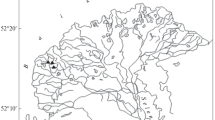Abstract
The development of an amebocytic reaction is described in tissues ofLymnaea truncatula infested byFasciola hepatica. When the snails are bred at 20° C (uniform temperature), this reaction is maximum after five to seven weeks of infestation; afterwards the intensity of the reaction decreases until 10 weeks of infestation. This reaction also develops in snails bred at different temperatures (uniform temperatures of 25° C or 16° C, daily fluctuations from 4° C to 18° C). The maximum intensity of this reaction is chronologically delayed as the temperature goes down. The young snails infested after hatching do not show amebocytic reaction. When the infested snails fast for seven days the number of amebocytes rapidly decreases; these cells disappear from tissues from a snail fasting for 14–35 days (depending on the snail organ). The significance of this amebocytic reaction is discussed.
Résumé
Les auteurs décrivent une réaction amibocytaire dans les tissus deLymnaea truncatula infestée parFasciola hepatica. Chez les mollusques élevés à 20°C maintenu constant, cette réaction atteint son maximum entre 5 à 7 semaines d'infestation; par la suite, l'intensité de la réaction décroît pour s'annuler vers 10 semaines d'infestation. Cette réaction se retrouve chez les limnées infestées élevées à diverses températures, soit constantes (25° C ou 16° C), soit présentant des fluctuations quotidiennes de 4° à 18°C: il existe un décalage chronologique de l'intensité maximale de cette réaction d'autant plus tardif que la température est basse. Les jeunes limnées infestées après leur éclosion ne montrent pas de réaction amibocytaire. Au bout de 7 jours de jeûne, les amibocytes diminuent en nombre; ils disparaissent des tissus de l'hôte pour un jeûne de 14 à 35 jours (selon l'organe considéré). La signification de cette réaction amibocytaire est discutée. L'évolution des parthenitae deFasciola hepatica chez la limnée tronquée entraîne le développement de lésions de nécrose survenant notamment au niveau des glandes digestive et génitale du mollusque (Rees, 1931; Southgate, 1969; Hodasi, 1972; Moore et Halton, 1973). Mais on admet actuellement que la limnée semble tolérer parfaitement son parasite (Kendall, 1965).
A l'inverse de la limnée tronquée, les espèces de limnées voisines présentent cependant des réactions de défense vis-à-vis des sporocystes deFasciola. Ces derniers peuvent être l'objet d'une réaction d'encapsulement faisant intervenir le «tissu conjonctif» et les amibocytes de la limnée vectrice (Kendall, 1965; Boray, 1966; Sazanov, 1972).
Ce type de réaction tissulaire est signalé aussi chez les mollusques vecteurs deSchistosoma sp. (Pan, 1965). Cet auteur décrit en plus une réaction cellulaire beaucoup plus tardive se manifestant lors des migrations des cercaires dans la cavité interne de l'hôte.
Le présent travail cherche à vérifier si les lésions tissulaires déjà signalées chez la limnée tronquée ne s'accompagneraient pas du développement d'une telle réaction cellulaire.
Similar content being viewed by others
Références
Barber, I.W.: The pathology produced in the snail,Lymnaea columella Say, 1817, by the larval stages ofFasciola hepatica L., 1758. Ph. D. Thesis, Berkeley, Univ. California, USA 1962
Boray, J.-C.: Studies on the relative susceptibility of some lymnaeids to infection withFasciola hepatica andF. gigantica and on the adaptation ofFasciola spp. Ann. Trop. Med. Parasitol.60, 114–124 (1966)
Hodasi, J.K.M.: The effects ofFasciola hepatica onLymnaea truncatula. Parasitology65, 359–369 (1972)
Kendall, S.B.: Relationships between the species ofFasciola and their molluscan hosts. Adv. Parasitol.3, 59–98 (1965)
Lie, K.J., Heyneman, D., Yau, P.: The origin of amebocytes inBiomphalaria glabrata. J. Parasitol.61, 574–576 (1975)
Moore, M.N., Halton, D.W.: Histochemical changes in the digestive gland ofLymnaea truncatula infected withFasciola hepatica. Z. Parasitenkd.43, 1–16 (1973)
Ollerenshaw, C.B.: Some observations on the epidemiology of fascioliasis in relation to the timing of molluscicide applications in the control of the disease. Vet. Rec.88, 152–164 (1971)
Pan, C.T.: Studies on the host-parasite relationship betweenSchistosoma mansoni and the snailAustralorbis glabratus. Am. J. Trop. Med. Hyg.14, 931–976 (1965)
Rees, F.G.: Some observations on the biology of larval trematodes. Parasitology23, 428–440 (1931)
Rondelaud, D.: L'évolution des rédies deFasciola hepatica L. chezGalba truncatula Müller en Limousin. Rev. Med. Vét125, 237–250 (1974a)
Rondelaud, D.: Recherches sur l'influence de quelques facteurs physiques sur les migrations quotidiennes deGalba truncatula Müller. Ann. Parasitol. Hum. Comp.49, 417–425 (1974b)
Rondelaud, D., Barthe, D.: Arguments et propositions pour une nouvelle interprétation de l'évolution deFasciola hepatica L. chezLymnaea (Galba) truncatula Müller. Ann. Parasitol. Hum. Comp.53, 201–213 (1978a)
Rondelaud, D., Barthe, D.: La reconstitution de l'épithélium digestif chezLymnaea (Galba) truncatula Müller après infestation par les formes larvaires deFasciola hepatica L. Ann. Parasitol. Hum. Comp53, 255–264 (1978b)
Sazanov, A.M.: A protective response of limnaeid molluscs to the penetration ofFasciola hepatica miracidia into them. Trudy Vses. Inst. Gel'mint.19, 163–169 (1972)
Southgate, V.R.: Studies on the biology and host-parasite relationships of some larval Digenea. Ph. D. Thesis, Univ. Cambridge, England 1969
Author information
Authors and Affiliations
Rights and permissions
About this article
Cite this article
Rondelaud, D., Barthe, D. Etude descriptive d'une réaction amibocytaire chezLymnaea truncatula Müller infestée parFasciola hepatica L.. Z. Parasitenkd. 61, 187–196 (1980). https://doi.org/10.1007/BF00925464
Received:
Issue Date:
DOI: https://doi.org/10.1007/BF00925464




